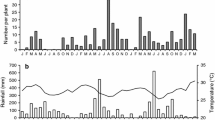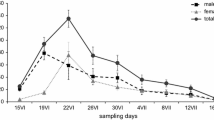Summary
This paper describes the results of a study of the factors determining the abundance and distribution of the Cinnabar Moth in Britain. The main part of the study was on a population of the moth at Weeting Heath in Norfolk. This is an area of sandy heath which is heavily overgrazed by rabbits. Here the moth fluctuates violently in number and periodically it completely defoliates its food plant (ragwort, Senecio jacobaea L.) over large areas. This happened in 1960, 1961, 1967, and 1968.
Since 1966, the numbers of the moth have been studied in detail and Life Tables are presented for five years.
Adult fecundity varies considerably between years. This is due mainly to fluctuations in adult size resulting from changes in larval density. By comparison adult mortality and dispersal have little effect on fecundity; although there is some evidence to suggest that dispersal is density dependent. Because the number of eggs laid in one generation depends on the size of the previous generation, fecundity tends to be acting as a delayed density dependent factor.
Mortality is low during the egg stage, but is high amongst young larvae, due mainly to arthropod predation. As the caterpillars grow they become immune from this predation. They are distasteful to vertebrate predators.
A larval parasite, Apanteles popularis, kills many of the fully grown larvae. The highest rates of parasitism have coincided with the lowest densities of the moth, however, so that over the five years it has acted as an inverse density dependent factor.
In 1967, the population became so large that the ragwort was completely defoliated, and about 20% of the caterpillars died from starvation. In the following year the population was still large and the ragwort plants were small, owing to the effects of defoliation in the previous year. Food ran out early in the season and about 50% of the larvae starved. Because of the overriding effect of starvation, total larval mortality tends to be density dependent.
Mortality is high at, or immediately after, pupation and this is thought to be due primarily to predation by moles (Talpa europaea). Pupal mortality does not appear to be density dependent.
The upward growth of the population is limited by food supply. Starvation led to a population crash, so that in 1969 only 62 eggs/150 m2 were laid compared with 17110 and 16493 in the previous two years. The rate of recovery of the population after this crash was dependent upon the rapid recovery of the ragwort plants. Owing to the wet summer in 1968, plant numbers actually increased after defoliation, due to regeneration from root buds. This was in spite of the fact that no seed was produced in the area in either 1967 or 1968.
The only factor which appears to buffer the population against extinction in years when food runs out early in the season, is the heterogeneity within the moth and ragwort populations. The earliest individuals manage to obtain sufficient food in those patches of ragwort which survive longest.
Large fluctuations in number only occur in some localities. Other populations of the moth persist at low density and never eat out their food supply. Some data are presented from such a population at Monks Wood. This site is on a heavy clay soil, rabbit grazing is less marked than at Weeting, and ragwort occurs only at a low density. The lusher vegetation supports a very large population of arthropod predators and these take a higher percentage of the young caterpillars than was found at Weeting. Pupal survival is also low due probably to waterlogging of the soil. Pupae can withstand considerable desiccation, but excessive moisture soon leads to their death.
The distribution of the moth in Britain and its use for the biological control of ragwort are discussed.
Similar content being viewed by others
References
Bornemissza G. F.: An attempt to control ragwort in Australia with the Cinnabar Moth, Callimorpha jacobaeae (L.) (Arctiidae: Leptoptera). Aust. J. Zool. 14, 201–243 (1966).
Bucher, G. E.: Harris, P.: Food-plant spectrum and elimination of disease of cinnabar moth larvae, Hypocrita jacobaeae (L.) (Lepidoptera: Actiidae). Canad. Ent. 93, 931–936 (1961).
Cameron E.: A study of the natural control of ragwort (Senecio jacobaea L.). J. Ecol. 23, 265–322 (1935).
Dempster, J. P.: A quantitative study of the predators on the eggs and larvae of the broom beetle, Phytodecta olivacea Forster, using the precipitin test. J. Anim. Ecol. 29, 149–167 (1960).
—: The analysis of data obtained by regular sampling of an insect population. J. Anim. Ecol. 30, 429–432 (1961).
—: The control of Pieris rapae with DDT. III. Some changes in the crop fauna. J. appl. Ecol. 5, 463–475 (1968).
—: Some effects of grazing on the population ecology of the Cinnabar Moth (Callimorpha jacobaeae L.). British Ecological Society Symposium on the scientific management of animal and plant communities for Conservation (ed. by E. Duffey and A. S. Watt), p. 517–526. Oxford: Blackwell Scientific Publications 1971.
Frazer, J. F. D., Rothschild, M.: Defence mechanisms in warningly coloured moths and other insects. Int. Congr. Ent. 11. Vienna 3, 249–256 (1960).
Frick, K. E., Holloway J. K.: Establishment of the cinnabar moth, Tyria jacobaeae, on tansy ragwort in the Western United States. J. econ. Ent. 57, 152–154 (1964).
Harper, J. L., Wood, W. A.: Biological flora of the British Isles, Senecio jacobaea L. J. Ecol. 45, 617–637 (1957).
Harris, P. Wilkinson, A. T. S., Neary, M. E., Thompson, L. S.: Senecio jacobaea L., tansy ragwort (Compositae). Tech. Commun. Commonw. Ints. biol. Control (in press).
Hawkes, R. B.: The Cinnabar Moth, Tyria jacobaeae, for control of Tansy Ragwort. J. econ. Entomol. 61, 499–501 (1968).
Jolly, G. M.: Explicit estimates from capture-recapture data with both death and immigration-stochastic model. Biometrika 52, 225–247 (1965).
Klop, H.: The dynamics of a field population of the pine looper, Bupalus piniarius L. (Lep., Geom.). Adv. Ecol. Res. 3, 207–305 (1965).
Meijden, E. van der: Senecio and Tyria (Callimorpha) in a Dutch dune area. Dynamics of numbers in populations (ed. by P. J. den Boer). Advanced Study Institute, Oosterbeek Netherland, 1970 (in press).
Morris, R. F.: The dynamics of epidemic Spruce Budworm populations. Mem. ent. Soc. Can. 31, 1–332 (1963).
Nicholson, A. J.: The balance of animal populations. J. Anim. Ecol. 2, 132–178 (1933).
—: An outline of the dynamics of animal populations. Aust. J. Zool. 2, 9–65 (1954).
Perring, F. H., Walters, S. M. (Ed.): Atlas of the British flora. London and Edinburgh: Thomas Nelson & Sons, Ltd. 1962.
Poole, A. L., Cairns, D.: Botanical aspects of ragwort (Senecio jacobaea L.) control. Bull. N. Z. Dep. Scient. ind. Res. 82, 1–61 (1940).
Rothschild, M.: Poisonous alkaloids in the body tissues of the Cinnabar Moth (Callimorpha jacobaeae L.). Nature (Lond.). 219, 747–748 (1968).
Steinhaus, E. A., Marsh, G. A.: Report of diagnoses of diseased insects 1951–1961. Hilgardia 33, 349–390 (1962).
Varley, G. C., Gradwell, G. R.: Key factors in populations studies. J. Anim. Ecol. 29, 399–401 (1960).
Watt, A. S.: Studies in the ecology of Breckland, IV The grass heath. J. Ecol. 28, 42–70 (1940).
Wilkinson, A. T. S.: Releases of cinnabar moth (Hypocrita jacobaeae L.) on tansy ragwort in British Columbia. Proc. ent. Soc. Br. Columb. 62, 10–12 (1965).
Windecker, W.: Euchelia (Hypocrita) jacobaeae L. und das Schutztrachtenproblem. Z. Morph. Ökol. Tiere 35, 84–138 (1939).
Author information
Authors and Affiliations
Rights and permissions
About this article
Cite this article
Dempster, J.P. The population ecology of the Cinnabar Moth, Tyria jacobaeae L. (Lepidoptera, Arctiidae). Oecologia 7, 26–67 (1971). https://doi.org/10.1007/BF00346293
Received:
Issue Date:
DOI: https://doi.org/10.1007/BF00346293




